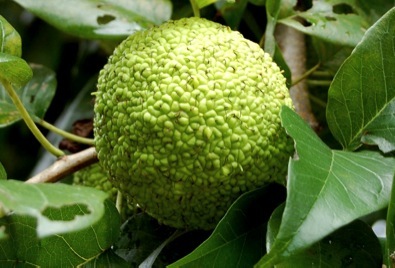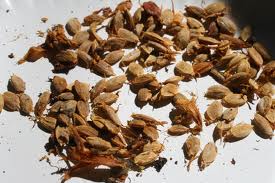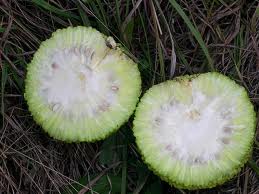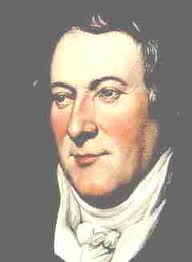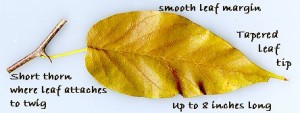Maclura pomifera: The Edible Inedible
Sometimes everybody is almost wrong.
If you Google “Osage Orange” or “Maclura pomifera” (mak-LOOR-uh pom-EE-fer-uh) (in 2009) you’ll get some 50,000 hits.* Approximately 49,997 of those sites will tell you the Osage Orange is not edible. Two of three remaining sites, here and the one below, will say it is edible. The third one reports we say it is edible but we must be wrong.
In all fairness, not all of the fruit is edible. Only the seeds are. In fact, the Osage Orange it is closely related to the Mulberries, which we do eat, and the Paper Mulberry which also has an edible fruit. But, 99.999999% of the Internet sites says it is not edible. Why? Two reasons. Somebody a long time ago said the fruit was not edible, and the Internet is mostly cut and paste wrong. I have truly become disgusted with sites like Wikipedia regarding the inaccurate information about plant edibility.
It was from Jim Mason, a naturalist with the Great Plains Nature Center in Wichita Kansas, that I learned the seeds were edible. They taste somewhat like raw sunflower seeds. Not bad for an inedible fruit though he does say it takes a lot of work to get the seeds, and he’s right. The Osage Orange grows in Florida — I know where there is one in Jacksonville. I have visited it several times. However, the tree grows in abundance in the mid-west, being part of the 1930’s reclamation process. It is, or was, the most intentionally planted tree in the United States. Its native range is a swath running from east Texas up into Oklahoma and parts of western Arkansas. It grows in 39 states and Washington DC, excluding the coldest and or driest areas, such as the high plain states and upper New England. Also found in Canada, it’s “invasive” in Italy and approaching invasive in Spain.
To separate the edible seeds from mature fruit put the fruit in a bucket of water and wait until the fruit is soft, then separate the seeds out. This will be an aroma-filled process and not pleasant. Let’s just say starving would help.
Also called Hedgeapples, the Osage Orange got some of its reputation from killing livestock. But careful investigation shows the animals usually suffocated on the large fruit. That got translated into “toxic.” But one livestock feeding study found no significant chemical problems with the Osage Orange. As for the seeds, birds and small mammals have enjoyed them for a long time. Squirrels seem particularly fond of ripping into one.
While the edibility of the Osage Orange has been maligned for decades, its usefulness as a tree has not. It was and still is esteemed for making bows. In fact, some bow makers think the Osage Orange’s wood for bows is superior to the Yew Tree, which is usually held up to be the classic standard. The wood is turned into various products or used to make guitars. The bark also furnishes a yellow dye and tannins.
Botanically, the Osage Orange, Maclura pomifera, was named for a Scottish-born semi-American geologist named William Maclure (1763-1840.) He moved around a lot so calling him an American is a bit iffy. Pomifera means bearing apples.
Green Deane’s “Itemized” Plant Profile
IDENTIFICATION: Tree to 40 feet and 20 inches diameter, often with a short thick trunk and numerous low branches. Bark gray to yellow-brown, thick, divided into narrow forking ridges, usually with hard sharp spines to one inch at leaf base. Sap thick, white, sticky. Leaves alternate, ovate, 2 to five inches long, one to three inches wide. Fruit large yellow-green knobby balls to five inches in diameter.
TIME OF YEAR: Fruit, smelling faintly of orange, in late summer, fall.
ENVIRONMENT: Bottom lands that are often inundated with water, mixed with other hardwoods, and interspersed with prairie, and grow where moderately dry as well.
METHOD OF PREPARATION: Seeds raw or roasted
*The original article was written in August 2009. Since then the number of hits has increased from 50,000 to 1.5 million (Sept 2014) and I think now a few more sites say the seeds are edible. One addition to make. I learned of a study that was looking for old homesteads to excavate in the midwest. They originally thought of using old wells as a possible homestead locator but found old Osage Orange trees were more indicative of a former homestead nearby. That says something about the usefulness of the tree.

